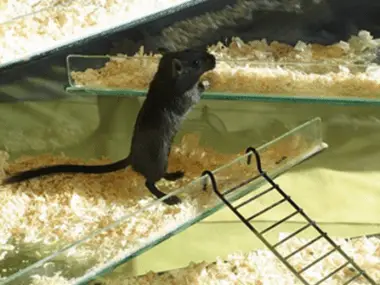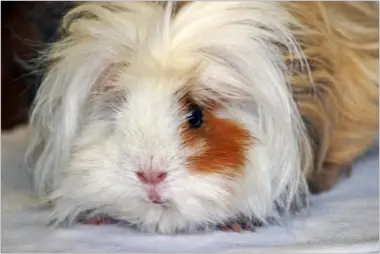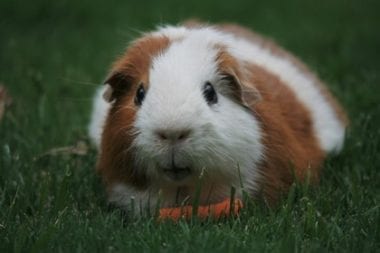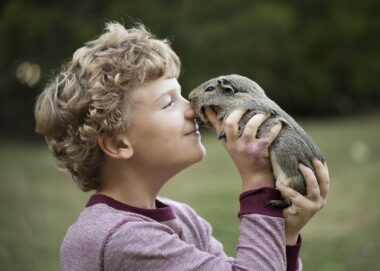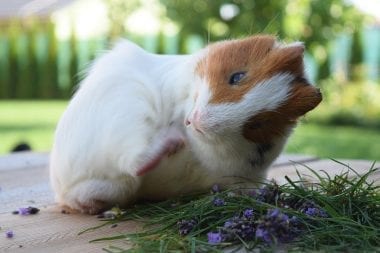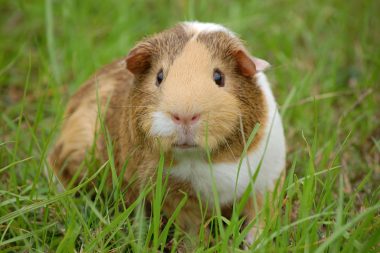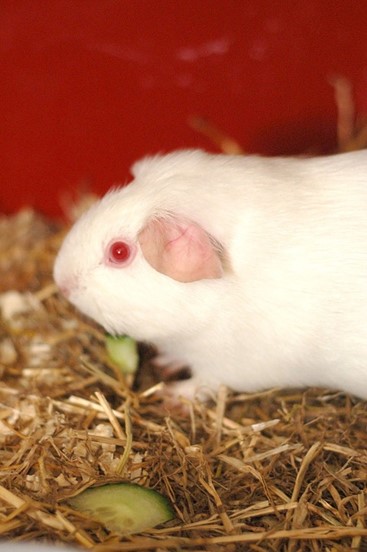
“Cavies” or guinea pigs are rough-haired and short-tailed rodents originating in South America. They have always been a preferred pet in households. These rodents are considered to be the finest pets for kids. Guinea pigs are cute, cuddly, as well as, are easy to take care of. They have a life span between four and seven years. Their minuscule droppings and nice small signify that you need to do minimum cleaning for them.
What are albino guinea pigs?
Several people think that an albino guinea pig refers to a white guinea pig, which has pink or red eyes. These guinea pigs are mostly owned and sold as pets. However, debates continue whether they are actually albino guinea pigs or not.
These quirky and cute White Crested guinea pigs are distinct because of an arrangement of white fur on their head. The article serves as a guide for how to take care of these guinea pigs. However, let us first see how the health of an albino guinea pig is different from other pets including other types of guinea pigs.
The health of albino guinea pigs
Let us now see what kind of health-related issues are faced by these guinea pigs as opposed to other pets. Overall, these guinea pigs are considered to be robust tiny animals. Irrespective of their color, these rodents are susceptible to certain common illnesses such as:
- Skin problems
- Stomach upsets
- Deficiency of vitamin C
- Stones in bladder
- Infections in respiratory tracts
However, if you look after them properly, all these above illnesses can be avoided or mitigated easily.
Health problems faced by albino guinea pigs
While these guinea pigs are typically more vulnerable to lose of hearing as compared to other guinea pigs, studies that have been conducted to confirm it has resulted in mixed outcomes. Studies have revealed though that the bone formation that takes place inside their eyes is usually more abnormal as compared to other guinea pigs. There is no clarity though on why it is more commonplace in pink-eyed guinea pigs than dark-eyed guinea pigs. It is unfortunate that there has been no unanimous agreement on how to prevent it and what are the causes for such growth.
Lethal white syndrome
The top symptoms of lethal white syndrome are as follows:
- Complete or partial blindness
- Missing or small eyes
- Deformed or missing teeth
- Complete or partial deafness
- Lack of ability to digest food properly and extract nutrients from it
A lethal white-colored guinea pig typically passes away quite early from a contagious disease that they cannot fight up. They may also die because of anesthetic for surgeries conducted to rectify their dental problems. It is only rarely that a white guinea pig with this syndrome can live beyond three years even when the pet owner takes plenty of care. Typically, the lifespan of a healthy guinea pig is between four and eight years.
Taking care of albino guinea pig
A white guinea pig has the same dietary requirements and habitat as guinea pigs belonging to different colors. It is imperative to note that white guinea pigs with pink eyes have a lack of pigment in them. That also means they are more susceptible to their eyes getting damaged from the sun.
The sun can also damage those parts of the skin, which are not covered by fur. If you want them to be safe, you have to ensure that there is proper access to shades even when you have taken them outdoors for running. You need to realize that a lethal white guinea pig requires lots of additional care for overcoming their disabilities. In case you have one, make sure to consult a knowledgeable guinea pig mentor or a vet for advice and guidance.
It is easy to take care of an albino guinea pig
They need fresh veggies, freshwater, hay, as well as, a tiny proportion of peeled food specifically designed for guinea pigs. They also need a regular vitamin C supplement. They should have a spacious cage along with proper paper-based bedding. You need to spot-clean this cage daily while complete cleaning should be done on a weekly basis. If you are not in favor of many tiny extra guinea pigs, it is better to separate the females and the males before they become a month old.
Guinea pigs are usually hardy
It means that when you take care of them and feed them properly, they can remain healthy. Similar to other pets, they may be vulnerable to specific diseases such as bladder stones and dental diseases. However, these conditions can be prevented to some extent if they get regular medical checkups and proper nutrition. Additionally, since these rodents are from cooler climates, it is difficult for them to be healthy where the climate is hot and humid. It is better to keep them inside to reduce the chance of them dehydrating or overheating.
Taking care of an albino guinea pig cage
1. Select a proper cage for the rodent
Though your guinea pig is bound to be tiny when it is a baby, it can grow bigger with time. Many of the cages available in the market may not be spacious enough for your pet. So, opt for a cage, which has a minimum size of 7.5 square feet. Initially, such a cage may look big for your young cavy, and yet it is the ideal size for accommodating an adult.
Are you going to keep two rodents in the same cage? Then, make sure that it has a minimum size of 10 square feet. A big cage will make sure that both can be comfortably accommodated.
2. A tray should be arranged for the cage with a wire bottom
Your pet will not be comfortable when the cage features a wire bottom. Hence, you should keep a tray, which is large enough to cover the cage’s bottom. It also facilitates the cleaning process as it is easy to slide it over.
3. Cover the cage’s bottom with bedding
Bedding options for the cage can include paper bedding, hay bedding, fleece bedding, and aspen bedding among others. Stay away from Pine or Cedar bedding because they are dangerous for guinea pigs.
4. Buy supplies for the cage
You have to get toys, a water bottle, a food dish, and proper bedding for the new pet.
5. Get one particular room ready- which you think will be safe for the new guinea pig
The new pet has to move around frequently. As such, it is imperative to dedicate one particular room in your home where they can stretch themselves properly. Additionally, ensure the following points mentioned below:
i) Remove all cables and wires, which the rodent might chew and has the chance of getting electrocuted.
ii) All other pets should be removed from the room. Although some guinea pigs may be friendly to cats, dogs, and other pets, many could be scared. Get it introduced to your other pets gradually and with caution. However, avoid rushing things and have a little patience in the beginning.
iii) Select room flooring, which is easy-to-clean so that your pet does not meet with an accident while exploring the floor.
iv) Shut all the doors so that your pet is unable to escape

Feeding a pet guinea pig
1. Buy commercial food available for guinea pigs- You may feed it around 1/8th cup of such food daily. Remove any leftovers so that it does not get spoiled.
2. Give supplement in form of fresh vegetables – You can feed them dark leafy green vegetables, which are the best. Then should be fed with one cup of these green vegetables daily. You may also give it a sweet potato or a few carrots twice a week.
3. Give adequate Timothy hay to your pet rodent– The front teeth of your pet will be growing continuously. So when you give it to chew Timothy hay, the teeth would not grow too long.
How to clean it?
1. Make sure that your guinea pig is brushed regularly so that a bath can be avoided if necessary
A guinea pig usually keeps itself clean. When your guinea pig has short hair, you can use a dry cloth to wipe it off. Brush the hair gently twice a week without fail. Meanwhile, a guinea pig with long hair should be brushed gently daily.
2. Apply special shampoo meant for small animals
Consult your vet to find out the shampoo type, which is best for your pet rodent. Stay away from human products meant for dogs or human shampoo. However, you can use a rabbit shampoo on your guinea pig. A medicated shampoo could be also essential when you are bathing a cavy that is ailing from a skin problem.
3. The room should be warmed up properly before giving it a bath
Does your guinea pig have a fungal condition on its skin? If that is the case, there is a possibility that it will require a bath. However, it is crucial that it does not catch cold. Turn of the fans or the AC to increase the temperature of the room where you will give it a bath.


